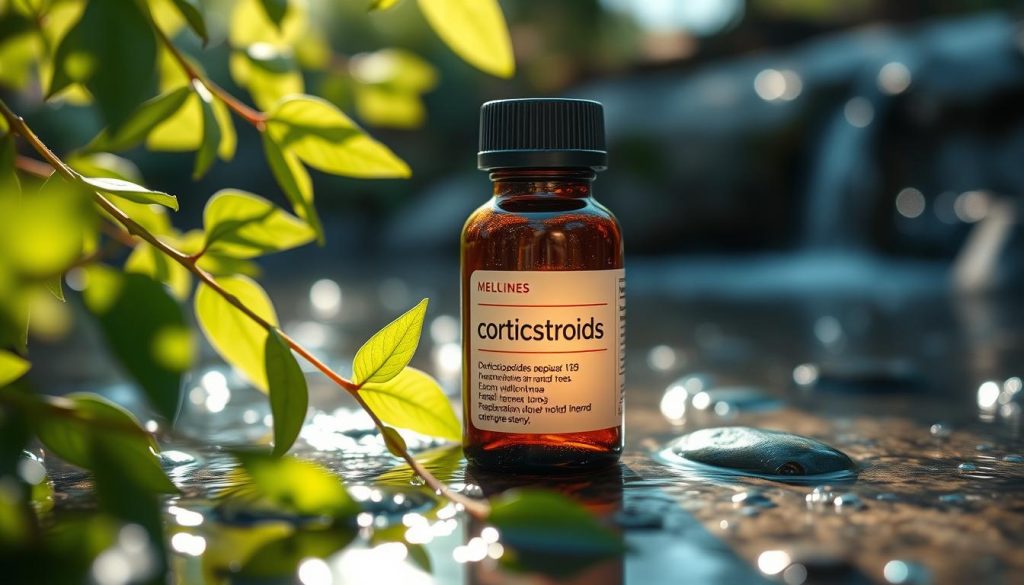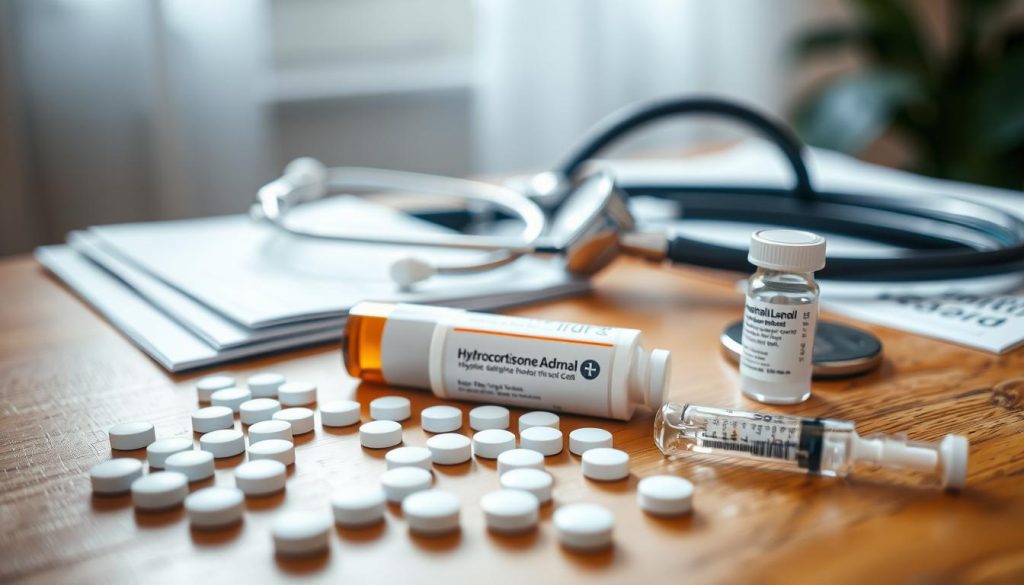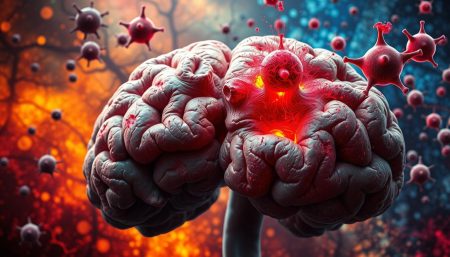When the body faces Addison’s disease, finding the right treatment is key. It’s important to understand how to treat it well. This helps patients feel more like themselves again.
Treating adrenal insufficiency involves many steps. These include hormone replacement and making lifestyle changes. It’s crucial to tackle this condition in a detailed way.
Starting the journey to wellness means learning about treatment. This guide will help you understand how to manage adrenal insufficiency. It offers hope for those dealing with this condition.
Key Takeaways
- Recognizing Addison’s disease is vital for timely and effective adrenal insufficiency treatment.
- Hormone replacement therapy is the cornerstone of managing Addison’s disease.
- Consistent medical oversight is essential for monitoring and adjusting treatment as needed.
- Dietary and lifestyle adjustments play a significant role in managing the condition.
- Being prepared for an adrenal crisis and understanding emergency care procedures is critical.
Understanding Addison’s Disease and Its Impact on Health
Exploring Addison’s disease starts with understanding its basics and the role of hormones in our health. This part will look into Addison’s disease, its symptoms, and why early diagnosis is key.
What Is Addison’s Disease?
Addison’s disease is a rare and chronic condition. It happens when the adrenal glands don’t make enough steroid hormones, like cortisol and aldosterone. This can be due to many Addison’s disease causes, such as autoimmune attacks, infections, or genetics, affecting the adrenal glands.
Addison’s Disease Symptoms
The signs of Addison’s disease start off mild but get worse over time. Symptoms include chronic fatigue, muscle weakness, weight loss, low blood pressure, and darker skin. Knowing these symptoms can help in getting an early Addison’s disease diagnosis, which is very important.
The Importance of Recognizing Early Signs
Spotting Addison’s disease early is vital. It helps avoid serious health crises and ensures better treatment. People who catch symptoms early often say they live a better life after being diagnosed and treated.

Critical First Steps in Addison’s Disease Diagnosis
The journey to manage Addison’s disease starts with a detailed Addison’s disease diagnosis. This involves a mix of clinical checks and special tests. For those suspecting adrenal insufficiency, doctors use various tests to confirm the disease and start the right adrenal insufficiency treatment.
Consulting with Healthcare Professionals
Seeing a doctor early is key if you think you might have Addison’s disease. Endocrinologists will look at your medical history and do a thorough physical exam. They work together to give each patient the best care.
Laboratory Tests and Imaging
Tests on blood and urine are key to diagnosing Addison’s disease. They check cortisol and ACTH levels. Doctors might also use CT scans or MRI to look at the adrenal glands, helping spot any problems.
Differential Diagnosis: Eliminating Other Conditions
To make sure the diagnosis is right, doctors rule out other conditions that might look similar. This step is important to avoid mistakes and find the real cause of adrenal insufficiency. It helps guide the treatment.
“Getting a precise diagnosis is key to treating Addison’s disease well. This is why specialized tests and the expertise of healthcare professionals are so important.”
Here’s a table showing the common tests used in diagnosis and what they focus on:
| Diagnostic Test | Focus Area |
|---|---|
| Blood Test | Cortisol and ACTH levels |
| ACTH Stimulation Test | Adrenal response to ACTH |
| Imaging (CT/MRI) | Structural assessment of adrenal glands |

The Cornerstone of Treatment: Corticosteroid Replacement Therapy
In managing Addison’s disease treatment, corticosteroid replacement therapy is key. It makes up for the lack of hormones from the adrenal glands. This is important but often not noticed until symptoms show up.

There are different types of corticosteroids for various needs. This makes Addison’s disease treatment both effective and personalized. It meets each patient’s unique hormonal needs.
| Type of Corticosteroid | Function | Common Dosage |
|---|---|---|
| Hydrocortisone | Mimics cortisol, helps manage stress and metabolism | 15-25 mg daily |
| Prednisone | Longer-acting, supports anti-inflammatory responses | 3-5 mg daily |
| Dexamethasone | Highly potent, used in minimal doses | 0.5-0.75 mg at night |
It’s important to watch the dosage and side effects of corticosteroid replacement therapy. Regular check-ups with doctors are key. They help keep the therapy effective and safe, reducing side effects and improving results.
How Do You Treat Addison’s Disease
Managing Addison’s disease needs a full plan. This includes treating adrenal insufficiency and making lifestyle changes. Finding the right balance can greatly improve life quality.
Maintaining Adequate Cortisol Levels
Keeping cortisol levels right is key for health in Addison’s disease patients. They often take hydrocortisone to match their body’s natural cortisol. Doctors help adjust doses for stress or illness to avoid crises.
Fludrocortisone and Sodium Intake for Aldosterone Replacement
Fludrocortisone helps replace aldosterone, which controls sodium, potassium, and water balance. Eating more sodium is helpful in hot weather or when being very active. But, it’s important to talk to a doctor about sodium intake to avoid problems.
- Regular monitoring of blood pressure and electrolytes to ensure the effectiveness of treatment and dietary adjustments.
- Education on recognizing the signs of dehydration or imbalances, which can prevent emergency situations.

People with Addison’s disease should stay in close touch with endocrinologists. They need to adjust their treatment as needed. Learning about how food and activities affect sodium levels and health is also helpful.
Managing and Preventing an Adrenal Crisis
Managing Addison’s disease symptoms is key to avoiding an adrenal crisis. This crisis can be deadly if not treated fast. It’s vital to know how to manage it well.
Here’s how to spot the signs, handle emergencies, and prevent future crises.
Recognizing Adrenal Crisis Symptoms
Knowing the signs of an adrenal crisis is crucial. Look out for sudden pain in the lower back, abdomen, or legs. Also, watch for severe vomiting, diarrhea, dehydration, low blood pressure, and loss of consciousness.
Spotting these symptoms early can save lives. It’s a key part of managing an adrenal crisis.
Emergency Treatment for Adrenal Crisis
Quick medical help is essential during an adrenal crisis. If you think you’re having one, get to the emergency room fast. Treatment usually involves hydrocortisone injections to control Addison’s disease symptoms.
Personalized Crisis Management Plans
Having a personal crisis plan is a smart health move. It improves your life and safety. The plan should list your medications, emergency contacts, and what to do in a crisis.
Keep updating this plan with your healthcare team. This makes sure it stays effective and up-to-date.
| Key Action | Details |
|---|---|
| Educate Family and Friends | Make sure those close to you know the crisis signs and how to act fast. |
| Carry Emergency Steroid Card | Always carry a card with your steroid use details and emergency contacts. |
| Regular Medical Review | Get yearly or biyearly medical checks to update your crisis plan as needed. |
Good adrenal crisis management practices help those with Addison’s disease live safely and proactively. Spotting symptoms early and having a ready emergency plan are key to managing this condition well.
Long-Term Management Strategies for Addison’s Disease
Living with Addison’s disease means you need a long-term plan to stay healthy. This plan includes watching your health closely, seeing doctors often, and making lifestyle changes. It’s important to work with your doctors and have a strong support system.
Regular medical check-ups are key to managing Addison’s disease. They help make sure your medicine is right and watch for any problems. Keeping a health journal of your symptoms and treatments is also helpful.
Having a good support network is crucial. This network can include doctors, counselors, and groups for people with Addison’s disease. They offer emotional support and practical advice. Talking to others who understand can help you feel less alone.
- Understanding medication side effects and interactions
- Engaging in gentle physical activities as recommended
- Keeping stress levels under check to prevent adrenal crises
Preventing Addison’s disease also means being educated. Knowing the signs of adrenal insufficiency and when to get help quickly is important.
| Preventive Strategy | Details |
|---|---|
| Emergency Medical ID | Carrying medical identification that alerts emergency personnel to Addison’s disease can expedite appropriate treatment. |
| Stress Management | Regular practice of relaxation techniques such as yoga, meditation, and controlled breathing. |
In summary, managing Addison’s disease well means being proactive. This includes regular health checks, talking to your doctors, and having a supportive community. With these steps, people with Addison’s disease can live full and happy lives.
Exploring the Role of Diet and Nutrition in Addison’s Disease
Managing Addison’s disease is more than just taking medicine. It also means making special diet changes. Knowing what foods to eat and what to avoid is key to keeping the condition under control.
Importance of Sodium and Potassium Balance
People with Addison’s disease need to watch their sodium and potassium levels. This is because their bodies don’t make enough aldosterone. Aldosterone helps keep these important minerals in balance. Eating the right foods can help manage this condition better.
Nutritional Supplements and Vitamin Needs
Those with Addison’s might need extra vitamins and supplements. It’s important to talk to a doctor about what’s best for you. This helps make sure you’re getting the nutrients you need, which is a big part of managing the disease.
| Nutrient | Importance | Recommended Sources |
|---|---|---|
| Sodium | Helps maintain fluid balance and prevent hypotension | Table salt, canned soups, and processed foods (in moderation) |
| Potassium | Supports heart and muscle function | Bananas, spinach, potatoes |
| Vitamin D | Essential for calcium absorption and bone health | Fatty fish, egg yolks, fortified foods |
| Calcium | Important for bone strength and cardiovascular health | Milk, cheese, yogurt, fortified plant milks |
Lifestyle Adjustments and Addison’s Disease Support
Living with Addison’s disease means making big lifestyle changes. It’s about understanding how to fit these changes into your daily life. This not only improves your health but also helps you manage your condition better.
Stress Management Techniques
Managing stress is key to keeping hormone levels stable. This is crucial for controlling Addison’s disease. Activities like meditation, yoga, and cognitive behavioral therapy are great. They teach you to handle stress in a healthy way.
Physical Activity Recommendations
Regular, moderate exercise is good for your health and stress levels. For people with Addison’s disease, activities like swimming, walking, and cycling are best. They boost your heart health without being too hard on your body.
Finding Effective Support and Resources
Having strong support networks is vital for managing Addison’s disease. Look for support groups, both in-person and online, and counseling services. They offer emotional support and practical tips for living with the condition.
Making lifestyle changes is easier with the right information and resources. Here’s a list of helpful adjustments and support options:
| Category | Description | Examples |
|---|---|---|
| Diet | High-sodium diet | Salted nuts, olives, and broth |
| Exercise | Low-impact, regular sessions | Walking, yoga, swimming |
| Stress Management | Techniques to reduce stress hormone release | Meditation, yoga, deep breathing exercises |
| Medical Care | Regular check-ups and medication adjustments | Endocrinologist visits |
| Support Groups | Communities offering emotional and informational support | Online forums, monthly meetings |
Conclusion
Dealing with Addison’s disease treatment needs patience and careful attention. We’ve covered key points for managing this condition. A good treatment plan includes medication, lifestyle changes, and support from others.
This approach is crucial for those with Addison’s disease. We hope this guide helps you and your family understand and tackle this condition confidently.
Managing Addison’s disease is a team effort. Working with doctors, staying updated on your health, and making healthy choices are important. We talked about the need for regular check-ups, being ready for emergencies, and eating right.
These steps are as vital as the medicine you take. They help you stay in control of your health.
To all facing Addison’s disease, we offer our support. Your determination and efforts towards better health can greatly improve your life. Use the knowledge you’ve gained to empower yourself.
And let the people around you support you. Together, you can navigate the path of Addison’s disease treatment and adrenal insufficiency treatment. Here’s to finding balance, strength, and well-being on your journey ahead.
FAQ
Q: What is Addison’s Disease?
A: Addison’s disease is a rare condition where the adrenal glands don’t make enough hormones. These hormones, like cortisol and aldosterone, are vital for our health. Managing this disease is key to staying healthy and avoiding serious problems.
Q: What are the symptoms of Addison’s Disease?
A: Symptoms include feeling very tired, weak muscles, losing weight, low blood pressure, and skin that’s darker than usual. Spotting these signs early is crucial for getting the right treatment.
Q: How is Addison’s Disease diagnosed?
A: Doctors use tests to check hormone levels and images to see the glands. They also rule out other conditions that might cause similar symptoms. This is called differential diagnosis.
Q: What is corticosteroid replacement therapy?
A: This therapy uses medicines to replace the missing hormones. For cortisol, they use hydrocortisone, and for aldosterone, fludrocortisone. It’s the main treatment for Addison’s disease.
Q: How should cortisol levels be maintained in Addison’s Disease?
A: Keeping cortisol levels right is done through replacement therapy. The dose is adjusted for each person. It’s also important to check levels often and adjust during stress or illness.
Q: What is an adrenal crisis and how is it managed?
A: An adrenal crisis is a serious situation with very low cortisol levels. It needs quick emergency care with injections and fluids. Having a crisis plan is vital.
Q: What long-term management strategies exist for Addison’s Disease?
A: Long-term care includes regular doctor visits, a balanced diet, stress management, and staying active. Building a support network and having an emergency alert are also important.
Q: How does diet affect Addison’s Disease management?
A: Diet is crucial for managing Addison’s disease. It’s important to keep sodium and potassium levels balanced. Sometimes, supplements are needed to support health.
Q: Which lifestyle adjustments can help manage Addison’s Disease?
A: To manage Addison’s disease, try stress-reducing activities, follow exercise guidelines, and connect with support groups. These changes can help a lot.


















